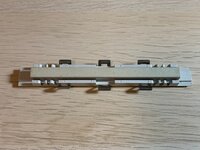David Cook
Well-known member
Here are some leftovers from various IIfx adventures.
Macintosh II, IIx, and IIfx Screws
These three computers share the same size fasteners for the securing the drive tray itself, the hard drive tray, and the floppy drive trays. Two more screws also hold the motherboard. I find a lot of these screws are missing from second-hand Macs. The Apple Service Source manual lists these as part #426-3401. Unfortunately, unlike other screws listed in the service guide, the dimensions are not provided for these.
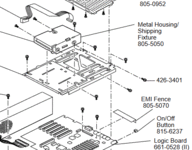
One would be forgiven for assuming these were #6-40 imperial screws. They are not. They are pan-head Phillips metric M3.5x0.6mm with a length of 8mm. They have an integrated external-tooth lock washer. I ordered separate screws (92000A153) and washers (95060A530) from McMaster-Carr. In hindsight, I wish I had located a variety where the lock washer was captive on the screw because it is a pain to find when it falls off.

Here is the new screw vs the original.

The screw that retains the lid at the back of the Macintosh is the same type M3.5-0.6mm but with a 10mm length. For the fun of it, I ordered a couple of these with a knurled head for easy removal. Their base nestles nicely in the U groove of the Mac. However, the portion that makes this so thumb-friendly for easy removal protrudes enough to snag on things. So, you'll need to weigh the odds of clumsy damage vs ease of access.
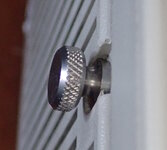
Newer Tech IIfx 4MB SIMMs in 1989?
One Macintosh IIfx computer that I received came with 4 sticks of 4MB RAM. What makes this interesting is the copyright date of 1989. The IIfx shipped in March 1990.

Since this was a new memory design, the 1989 date is not likely leftover from 30-pin SIMM gerbers. Instead, it seems like Apple must have made the pinouts and specifications available prior to the computer's release. I know the Laserwriter NTX also used 64-pin SIMMs.
I suppose this layout could have been generated for 1 MB SIMMs and then the boards reused for 4 MB SIMMs later on. But, I like to imagine how expensive these would have been if they were produced at the IIfx launch.
Broken Programmer Switch
The previous owner of this IIfx had a solution for broken plastic tabs on the programmer / interrupt switch -- glue it on.
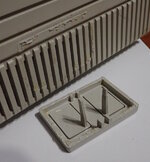
While that does work, it prevents the removal of the motherboard for servicing.
Fix for No Power
This IIfx did not power on when the rear power button or keyboard power key was pressed. I mean, the power supply fan didn't even spin up.
This is pretty common for the Macintosh II and Macintosh IIx computers, as the trace running to the rear switch and ADB port is often corroded by a leaking capacitor in the presence of battery voltage on that trace. The IIfx suffers more often from a broken trace due to C9. For this computer, the area around C9 was clean and the battery holders showed no sign of battery damage.
With batteries installed but the power cord unplugged, I start at the power supply connector and make my way back to the area around UJ18 and C24, measuring voltages along the way. This is the power start-up circuit and it will operate purely from battery supply. We should see the voltages toggle when the power supply button is pressed. For me, some of these test points were zero volts and some were half what I expected (about 3V rather than about 6V).
With a flashlight, I peeked inbetween the SIMM slot and the BT1 battery holder. You can just make out brown corrosion on a trace.
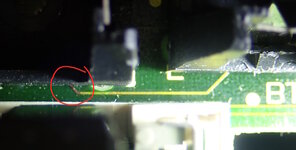
Ugg. This means I need to remove the battery holder. Ok. Here's what I found. Defintely a single damaged trace -- but not that bad overall.
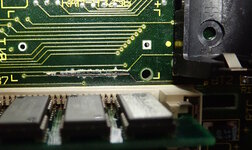
This trace connects BT1 to BT2. It explains the half voltage. Cleaning and replacing the trace with a wire fixed the problem.
Fix for IIfx Power On But No Chime
Another IIfx had a very different problem. It would power up, but not chime, enable video, or produce SCSI activity.
* Recapped (prior to testing) and all capacitors are in the correct orientation
* Checked power supply voltages. Good.
* Checked for broken traces. None. Very clean board.
* Pulled all RAM from bank B. No need to complicate things. Tested bank A RAM in a different computer and then reseated it in this IIfx. I've found that the IIfx may not chime at all if bad RAM is present in bank A.
* Swapped the ROM for a modern edition. No improvement. Original ROM good.
* Swapped the 68030 CPU for a known-working chip. No improvement. Original CPU good.
Nothing helped. At this point, I assume I'm in for a long diagnostic session. I pulled the CPU and measured two particular pins in the CPU socket after power up. The ~RESET pin must be high. If it is low, then the CPU will be held in a stopped state. The CLIN (clock in) pin must show an oscillating voltage. If you have a multimeter, it should read around 2.5 or fluctate. It should not be a steady 0 or 5. On an oscilliscope, you can actually see and measure the 40 MHz clock signal.

On this IIfx, the clock pin was steady 0V. Ah ha!
Believe it or not, the 80 MHz full-can oscillator was broken. I removed it, socketed it, and replaced it. After that, the IIfx worked fine.
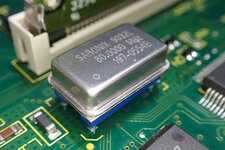
I've had a couple of 32.768K crystals go bad in IIsi computers, but this is the first full oscillator I've had problems with. Maybe the ultrasonic cleaner killed it? Maybe it took a blow in shipping?
Images of a IIfx Box
Lastly, one of the IIfx computers came with its original box. In case it is of interest, here are some pictures.
The other sides of the box mirror the sides shown below.
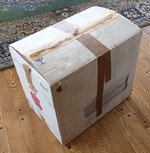

F3032MAQC40 is the serial number on the back of the Mac itself. The serial numbers on all of my Mac IIfx machines give fits to the web serial number decoders. What I assume is 'F3' is the Fremont factory, 0 is 1990, 32 is the 32nd week. 'MAQ' is the quantity produced for that factory+year+week to give it a unique number. C40 is the configuration. I've also seen C41.
Slightly different number on the inside sticker, starting with 'F1' and ending with M5515LL/A
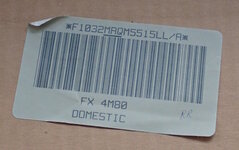
The IIfx stood vertically on its narrowmost end in the box. I assume 'power supply down'.
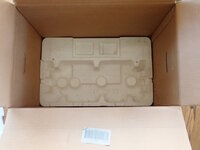
Here's the top lid.
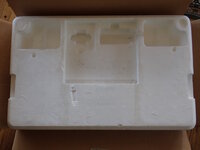
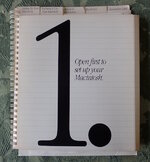
Notice the little 'IIfx' sticker below. Should I peel it off to see what is underneath? Probably nothing.
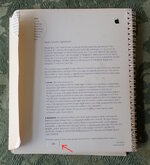
I didn't realize you could buy the IIfx with A/UX installed.
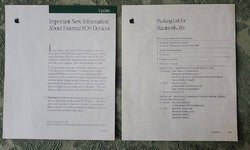
"every Macintosh IIfx has a built-in terminator" -- mmmm, I think they should say "an internal terminator installed". I don't think it is built into the board.



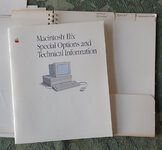
The original owner did not register with Apple and did not receive their free gift of a refurbished Macintosh Portable.

I hope some of this is helpful,
- David
Macintosh II, IIx, and IIfx Screws
These three computers share the same size fasteners for the securing the drive tray itself, the hard drive tray, and the floppy drive trays. Two more screws also hold the motherboard. I find a lot of these screws are missing from second-hand Macs. The Apple Service Source manual lists these as part #426-3401. Unfortunately, unlike other screws listed in the service guide, the dimensions are not provided for these.

One would be forgiven for assuming these were #6-40 imperial screws. They are not. They are pan-head Phillips metric M3.5x0.6mm with a length of 8mm. They have an integrated external-tooth lock washer. I ordered separate screws (92000A153) and washers (95060A530) from McMaster-Carr. In hindsight, I wish I had located a variety where the lock washer was captive on the screw because it is a pain to find when it falls off.

Here is the new screw vs the original.

The screw that retains the lid at the back of the Macintosh is the same type M3.5-0.6mm but with a 10mm length. For the fun of it, I ordered a couple of these with a knurled head for easy removal. Their base nestles nicely in the U groove of the Mac. However, the portion that makes this so thumb-friendly for easy removal protrudes enough to snag on things. So, you'll need to weigh the odds of clumsy damage vs ease of access.

Newer Tech IIfx 4MB SIMMs in 1989?
One Macintosh IIfx computer that I received came with 4 sticks of 4MB RAM. What makes this interesting is the copyright date of 1989. The IIfx shipped in March 1990.

Since this was a new memory design, the 1989 date is not likely leftover from 30-pin SIMM gerbers. Instead, it seems like Apple must have made the pinouts and specifications available prior to the computer's release. I know the Laserwriter NTX also used 64-pin SIMMs.
I suppose this layout could have been generated for 1 MB SIMMs and then the boards reused for 4 MB SIMMs later on. But, I like to imagine how expensive these would have been if they were produced at the IIfx launch.
Broken Programmer Switch
The previous owner of this IIfx had a solution for broken plastic tabs on the programmer / interrupt switch -- glue it on.

While that does work, it prevents the removal of the motherboard for servicing.
Fix for No Power
This IIfx did not power on when the rear power button or keyboard power key was pressed. I mean, the power supply fan didn't even spin up.
This is pretty common for the Macintosh II and Macintosh IIx computers, as the trace running to the rear switch and ADB port is often corroded by a leaking capacitor in the presence of battery voltage on that trace. The IIfx suffers more often from a broken trace due to C9. For this computer, the area around C9 was clean and the battery holders showed no sign of battery damage.
With batteries installed but the power cord unplugged, I start at the power supply connector and make my way back to the area around UJ18 and C24, measuring voltages along the way. This is the power start-up circuit and it will operate purely from battery supply. We should see the voltages toggle when the power supply button is pressed. For me, some of these test points were zero volts and some were half what I expected (about 3V rather than about 6V).
With a flashlight, I peeked inbetween the SIMM slot and the BT1 battery holder. You can just make out brown corrosion on a trace.

Ugg. This means I need to remove the battery holder. Ok. Here's what I found. Defintely a single damaged trace -- but not that bad overall.

This trace connects BT1 to BT2. It explains the half voltage. Cleaning and replacing the trace with a wire fixed the problem.
Fix for IIfx Power On But No Chime
Another IIfx had a very different problem. It would power up, but not chime, enable video, or produce SCSI activity.
* Recapped (prior to testing) and all capacitors are in the correct orientation
* Checked power supply voltages. Good.
* Checked for broken traces. None. Very clean board.
* Pulled all RAM from bank B. No need to complicate things. Tested bank A RAM in a different computer and then reseated it in this IIfx. I've found that the IIfx may not chime at all if bad RAM is present in bank A.
* Swapped the ROM for a modern edition. No improvement. Original ROM good.
* Swapped the 68030 CPU for a known-working chip. No improvement. Original CPU good.
Nothing helped. At this point, I assume I'm in for a long diagnostic session. I pulled the CPU and measured two particular pins in the CPU socket after power up. The ~RESET pin must be high. If it is low, then the CPU will be held in a stopped state. The CLIN (clock in) pin must show an oscillating voltage. If you have a multimeter, it should read around 2.5 or fluctate. It should not be a steady 0 or 5. On an oscilliscope, you can actually see and measure the 40 MHz clock signal.

On this IIfx, the clock pin was steady 0V. Ah ha!
Believe it or not, the 80 MHz full-can oscillator was broken. I removed it, socketed it, and replaced it. After that, the IIfx worked fine.

I've had a couple of 32.768K crystals go bad in IIsi computers, but this is the first full oscillator I've had problems with. Maybe the ultrasonic cleaner killed it? Maybe it took a blow in shipping?
Images of a IIfx Box
Lastly, one of the IIfx computers came with its original box. In case it is of interest, here are some pictures.
The other sides of the box mirror the sides shown below.


F3032MAQC40 is the serial number on the back of the Mac itself. The serial numbers on all of my Mac IIfx machines give fits to the web serial number decoders. What I assume is 'F3' is the Fremont factory, 0 is 1990, 32 is the 32nd week. 'MAQ' is the quantity produced for that factory+year+week to give it a unique number. C40 is the configuration. I've also seen C41.
Slightly different number on the inside sticker, starting with 'F1' and ending with M5515LL/A

The IIfx stood vertically on its narrowmost end in the box. I assume 'power supply down'.

Here's the top lid.


Notice the little 'IIfx' sticker below. Should I peel it off to see what is underneath? Probably nothing.

I didn't realize you could buy the IIfx with A/UX installed.

"every Macintosh IIfx has a built-in terminator" -- mmmm, I think they should say "an internal terminator installed". I don't think it is built into the board.




The original owner did not register with Apple and did not receive their free gift of a refurbished Macintosh Portable.

I hope some of this is helpful,
- David

